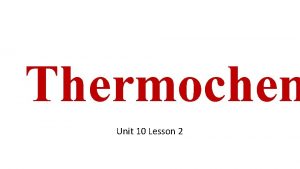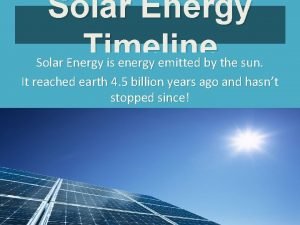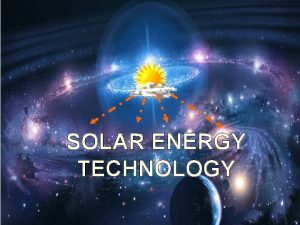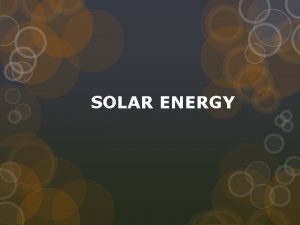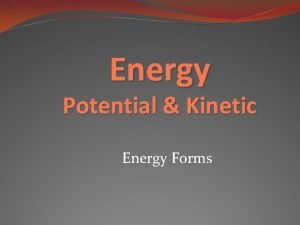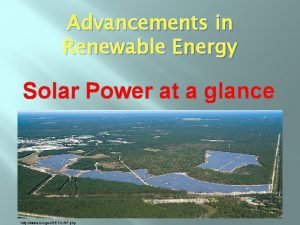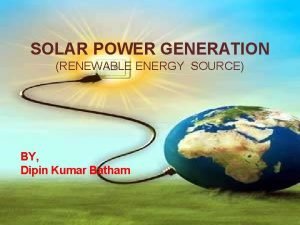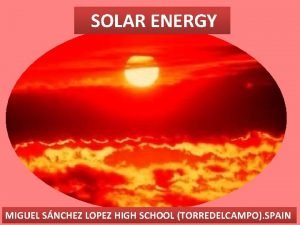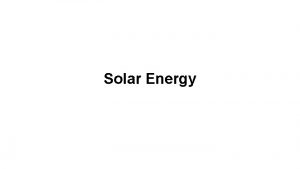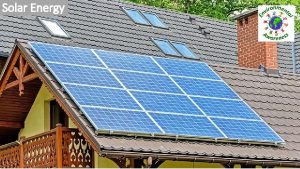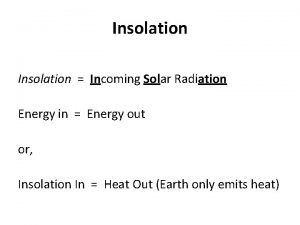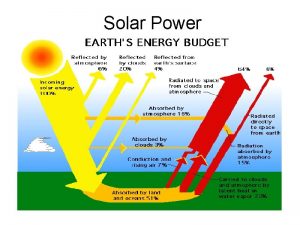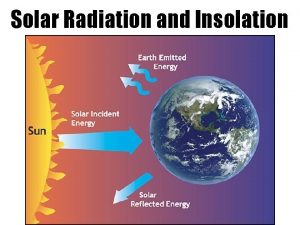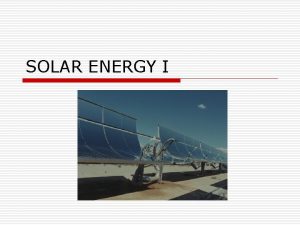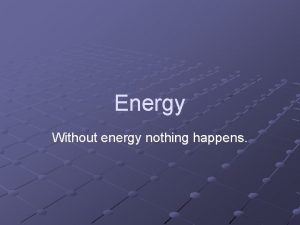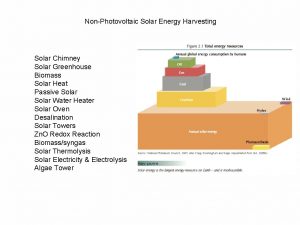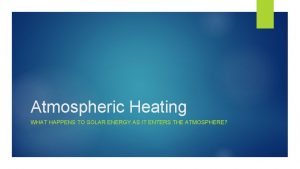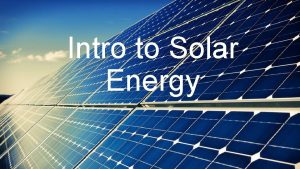Solar Energy What happens to that INcoming SOLar
































- Slides: 32

Solar Energy • What happens to that INcoming SOLar radi. ATION?

• The sun delivers heat energy to Earth’s surface. • This is called radiation. • This heat energy is absorbed and also radiated back into space. • The physical characteristics of Earth’s surface affect how much heat energy is absorbed.



Albedo • Taken from the Latin, alba, for white. • The measure of “whiteness”, or more specifically, how much solar radiation a surface will reflect. • An albedo measurement of ZERO has no reflectivity, “black” – absorbs all radiation • A measurement of ONE is the highest and the “whitest” and the more reflective. • Now used as a generic term for how much solar radiation will be absorbed or reflected by a surface.

Things that effect Albedo • • • Color: The darker an object, the more heat it absorbs. Texture: The rougher an object, the more heat it absorbs. Therefore, dark and rough objects (like rocks) absorb the most heat. • Light and smooth objects (like water and snow) do not absorb much at all. Instead, they reflect heat.

Which one will get the hottest, the fastest? A B C

https: //sunrise-sunset. org/us/buffalo-ny

What’s going to heat up faster? ? ? Why? ? ?

Energy Transfer • Energy in the atmosphere and at Earth’s surface is transferred in two main ways: • 1. Conduction is the transfer of energy when molecules collide, or actually come in contact with each other. • 2. Convection is the transfer of energy through Such as: Itair, and magma a substance. is a water, circular motion!! – Warm air rises (due to low density), it then expands and cools (density is now high), so the air then sinks back down. This occurs over and over again.

Energy Transfer • Think of a pot of boiling water. • Conduction is going on when the flame comes in contact with the pan and heats it up. • Then convection occurs within the water itself allowing all the water molecules to heat up and begin to boil.


LOW PRESSURE HIGH PRESSURE AIR GO? ? Land Air is Warm HIGH TO LOW Water Air is Cold



Temperature • Temperature and heat are NOT the same thing! • Heat is an actual energy that’s transferred. • Temperature is a measurement of that energy. • Let’s remind ourselves of the relationship between temperature and density and temperature and pressure.

Temperature • As temperature increases, density decreases and vice-versa. • As temperature increases, pressure decreases, and vice-versa. • Keep these in mind in the next few days, these are VERY important relationships in weather! • ESRT ALERT!! – Remember on page 13 you will find a temperature conversion scale that will be very useful!

freezes Remember, ice melts and freezes at the same temperature Melts

Specific Heat • The specific heat of a substance is its resistance to heating up or cooling off. • If something’s specific heat is high, it takes a long time to heat up, but will keep the heat for a long time.

Specific Heat If something’s specific heat is low, it will heat up quickly, but also lose the heat quickly. ESRT ALERT!! – Page 1 contains a chart with the specific heats of some common materials.

Water has a very high specific heat – takes a long time to heat water up, but once it’s warm it stays warm for a long time. Metals, like lead and copper have low specific heats – they will heat up very quickly, but cool down very fast too.

Data Gathered in Classroom

Equal masses of lead, granite, basalt, and water at 55° C are exposed to equal quantities of heat energy. Page 1 of ESRT’s rise of Which would be the first to show temperature 10°C? Important! The larger 1. Lead the specific heat 2. Granite 3. Basalt number, the longer it 4. Water takes to heat up and the longer it takes to cool down. Water has a very high specific heat – takes a long time to heat water up, but once it’s warm it stays warm for a long time. Metals, like lead and copper have low specific heats – they will heat up very quickly, but cool down very fast too.

Weather • Current state or conditions of our atmosphere. • Climate - average weather for an area over many years.

Weather • Weather is a short-term thing and occurs over small areas! • On the other hand, climates are longterm and cover large areas. • Meteorology is the study of atmospheric phenomena. • For example: clouds, raindrops, snowflakes, fog, dust, and rainbows.

Weather It’s raining It’s snowing

CLIMATE cold, snowy winters warm, wet summers

Causes of Weather • The main cause of weather is due to an imbalance of the sun’s rays hitting the Earth. • The sun’s rays DO NOT hit all spots on the Earth with the same intensity. • Higher latitudes (above Tropics of Cancer and Capricorn) have low intensity sun’s rays. • Lower latitudes (between Tropics of Cancer and Capricorn) have high intensity sun’s rays. • It all has to do with the angle of the sun’s rays!

the uneven heating of the Earth’s Surface Same amount of light spread over greater area.

Direct Light Summer Indirect Light - Winter


Causes of Weather • This difference of the sun’s rays causes heat energy to constantly be redistributed, mostly through convection. • Everything then gets brought into balance once the energy gets redistributed. • This entire process creates weather!
 Solar energy is free. solar is inexhaustible
Solar energy is free. solar is inexhaustible Phân độ lown ngoại tâm thu
Phân độ lown ngoại tâm thu Premature atrial contraction
Premature atrial contraction Thể thơ truyền thống
Thể thơ truyền thống Thơ thất ngôn tứ tuyệt đường luật
Thơ thất ngôn tứ tuyệt đường luật Chiến lược kinh doanh quốc tế của walmart
Chiến lược kinh doanh quốc tế của walmart Tìm vết của mặt phẳng
Tìm vết của mặt phẳng Con hãy đưa tay khi thấy người vấp ngã
Con hãy đưa tay khi thấy người vấp ngã Tôn thất thuyết là ai
Tôn thất thuyết là ai Gây tê cơ vuông thắt lưng
Gây tê cơ vuông thắt lưng Sau thất bại ở hồ điển triệt
Sau thất bại ở hồ điển triệt Wind energy is an indirect form of solar energy
Wind energy is an indirect form of solar energy Inward mail register
Inward mail register Unit 1 dealing with incoming calls
Unit 1 dealing with incoming calls Incoming sales
Incoming sales Procedures before telephoning
Procedures before telephoning Medical assistant telephone techniques
Medical assistant telephone techniques Walled garden mikrotik
Walled garden mikrotik Incoming sensory impulses and outgoing motor impulses
Incoming sensory impulses and outgoing motor impulses What is the correct sequence in a typical reflex arc
What is the correct sequence in a typical reflex arc Agresso maintenance
Agresso maintenance Does potential energy decrease with temperature
Does potential energy decrease with temperature Energy energy transfer and general energy analysis
Energy energy transfer and general energy analysis Energy energy transfer and general energy analysis
Energy energy transfer and general energy analysis Wholesale solar power panel
Wholesale solar power panel Timeline of solar energy
Timeline of solar energy Solar energy syllabus
Solar energy syllabus What is radiant light
What is radiant light Forms of energy
Forms of energy Avi solar energy pvt ltd
Avi solar energy pvt ltd Advancements in solar energy
Advancements in solar energy Conclusion of solar energy
Conclusion of solar energy Solar energy advantges
Solar energy advantges





















